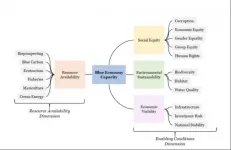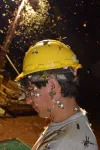(Press-News.org) Among adults with children living in the home, cannabis use was more common in states with legalized cannabis use, according to a new study by Columbia University Mailman School of Public Health, Columbia Irving Medical Center and the City University of New York. Legalization for recreational and medical use were both linked with significantly higher prevalence of past-month and daily cannabis use. Until now, most tobacco control and harm reduction efforts protecting youth from exposure to secondhand tobacco smoke focused on parental cigarette smoking, ensuring smoke-free homes, and not smoking in the presence of children. The findings are published in the journal Addiction.
The potential risks of exposure to secondhand cannabis smoke and education on the merits of protecting youth from exposure to secondhand cannabis smoke have received little attention in the cannabis legalization effort, according to Epidemiologist Renee Goodwin, PhD, MPH, at Columbia Mailman School of Public Health and lead investigator.
"If legalization for medical or recreational purposes has increased cannabis use among adults living in the home with children, adults deserve education about the risks of secondhand smoke to youth, as well as information on any other risks to their children associated with parental cannabis use," said Goodwin. "In contrast to cigarettes, there are no public health or clinical guidelines for parents designed to address or educate about best practices for use of cannabis toward avoiding or reducing harmful exposures of secondhand smoke to children's health."
The researchers analyzed data from the 2004-2017 National Survey on Drug Use and Health, an annual representative survey on substance use and mental health of individuals ages 12 and older, to determine past-30-day cannabis use and daily cannabis use by age, gender, annual family income, and educational attainment as well as cannabis legalization.
In states where cannabis is legal for recreational purposes, 12 percent of the adults reported past-month use, and 4 percent used daily. For states with medical marijuana laws, the percentage of users in the month dropped to 9 percent, and to 6 percent in states without legalization laws. On a daily basis, adults reported using at 4.2 percent, 3.2 percent, and 2.3 percent, respectively.
Legalization for recreational use was associated with significant jumps in cannabis use among adults with children living in the home. The effect of legalization for medical use was concentrated more among parents who are older, with higher income and education levels. While increases in states with recreational legalization were observed consistently across all demographic groups.
Since secondhand cannabis smoke exposure has a number of undesirable health risks for youth, and adolescents with parents who use cannabis are at increased risk of cannabis use themselves, estimating the degree to which cannabis use has increased among adults with children in the home, is critical to inform the allocation of resources for prevention and intervention efforts, according to Goodwin.
"As an increasing number of states legalize cannabis for medical or recreational use, educational efforts to reduce children's exposure to secondhand cannabis smoke may be essential to protect children in this era of new or rapidly shifting cannabis policy," Goodwin noted.
INFORMATION:
The study was supported by the National Institutes of Health/National Heart, Lung and Blood Institute, R21-HL149773, and National Institute on Drug Abuse, R01-DA20892.
Co-authors include June Kim, City University of New York; Keely Cheslack-Postava, Columbia University Medical Center, Pschiatry; Andrea Weinberger, Yeshiva University; Melody Wu, Columbia University Mailman School of Public Health and City University of New York School of Public Health; Katarzyna Wyka, City University of New York School of Public Health; and Meyer Kattan, NewYork-Presbyterian/Columbia University Medical Center, Pediatrics.
Columbia University Mailman School of Public Health
Founded in 1922, the Columbia University Mailman School of Public Health pursues an agenda of research, education, and service to address the critical and complex public health issues affecting New Yorkers, the nation and the world. The Columbia Mailman School is the seventh largest recipient of NIH grants among schools of public health. Its nearly 300 multi-disciplinary faculty members work in more than 100 countries around the world, addressing such issues as preventing infectious and chronic diseases, environmental health, maternal and child health, health policy, climate change and health, and public health preparedness. It is a leader in public health education with more than 1,300 graduate students from 55 nations pursuing a variety of master's and doctoral degree programs. The Columbia Mailman School is also home to numerous world-renowned research centers, including ICAP and the Center for Infection and Immunity. For more information, please visit http://www.mailman.columbia.edu.
The future of an equitable and sustainable global ocean, or "Blue Economy," depends on more than the resources available for technological advancement and industry expansion. A recent UBC-led study found that socioeconomic and governance conditions such as national stability, corruption and human rights greatly affect the ability to achieve a Blue Economy.
The study, published today in Nature, scored criteria across five global regions: Africa, Americas, Asia, Europe and Oceania, to identify the areas of investment and research necessary to develop ocean resources in a manner that is consistent with a Blue Economy ethos (socially ...
To observe how a tiny ball of identical cells on its way to becoming a mammalian embryo first attaches to an awaiting uterine wall and then develops into nervous system, heart, stomach and limbs: This has been a highly-sought grail in the field of embryonic development for nearly 100 years. Prof. Jacob Hanna of the Weizmann Institute of Science and his group have now accomplished this feat. The method they created for growing mouse embryos outside the womb during the initial stages after embryo implantation will give researchers an unprecedented tool for understanding the development program encoded in the genes, and it may provide detailed insight into birth and developmental defects as well as those involved ...
Forces acting inside the Earth have been constantly reshaping the continents and ocean basins over millions of years. What Alfred Wegener published as an idea in 1915 has finally been accepted since the 1960s, providing a unifying view about our planet. The fact that the theory of plate tectonics took so long to gain acceptance had two simple reasons. First, the geological formations that are most important for its understanding lie at the bottom of the oceans. Secondly, forces controlling the processes act below the seafloor and are hence hidden from our view. Many details of plate tectonics are therefore still unclear today.
Today, ...
Tucson, Ariz. (March 16, 2021) - This week, a new, peer-reviewed scientific study finds that there is far more potential jaguar habitat in the U.S. than was previously thought. Scientists identified an area of more than 20 million acres that could support jaguars in the U.S., 27 times the size of designated critical habitat.
The results, published in the journal Oryx, are based on a review of 12 habitat models for jaguars within Arizona and New Mexico, conclusively identifying areas suitable for the recovery of these wild cats. Based on the expanded habitat area, the authors conclude that findings uncover new opportunities for jaguar conservation in North America that ...
Researchers have channeled the universe's earliest light - a relic of the universe's formation known as the cosmic microwave background (CMB) - to solve a missing-matter mystery and learn new things about galaxy formation. Their work could also help us to better understand dark energy and test Einstein's theory of general relativity by providing new details about the rate at which galaxies are moving toward us or away from us.
Invisible dark matter and dark energy account for about 95% of the universe's total mass and energy, and the majority of the 5% that is considered ordinary matter is also largely unseen, such as the gases at the outskirts of galaxies that comprise their so-called halos.
Most ...
Imagine not a white, but a green Arctic, with woody shrubs as far north as the Canadian coast of the Arctic Ocean. This is what the northernmost region of North America looked like about 125,000 years ago, during the last interglacial period, finds new research from the University of Colorado Boulder.
Researchers analyzed plant DNA more than 100,000 years old retrieved from lake sediment in the Arctic (the oldest DNA in lake sediment analyzed in a publication to date) and found evidence of a shrub native to northern Canadian ecosystems 250 miles (400 km) farther north than its current range.
As the Arctic warms much ...
An estimated 14,480 new cases of invasive cervical cancer will be diagnosed in the United States this year, according to the American Cancer Society. Cases that could be prevented or cured with better education from screening to treatment based on improved provider-patient communication, says a Michigan State University researcher.
The issue is particularly acute for Black women, said Sabrina Ford, an associate professor in the Department of Obstetrics, Gynecology and Reproductive Biology within MSU's College of Human Medicine. Ford's research was published ...
Artificial light at night (ALAN) is a major factor in global insect decline. In a paper published today in Insect Conservation and Diversity, Smithsonian Conservation Biology Institute (SCBI) scientists and partners found that using amber-colored filters to remove the blue spectra of light from "warm white" LED (light-emitting diode) lamps drastically reduces insect attraction to nocturnal lighting in a tropical forest. This is the first study to validate quantitative predictions of how lamp color affects insect attraction and provide clear recommendations to mitigate the negative impacts of ALAN on wildlife in rainforest ecosystems.
"While ...
Many bacteria swim towards nutrients by rotating the helix-shaped flagella attached to their bodies. As they move, the cells can either 'run' in a straight line, or 'tumble' by varying the rotational directions of their flagella, causing their paths to randomly change course. Through a process named 'chemotaxis,' bacteria can decrease their rate of tumbling at higher concentrations of nutrients, while maintaining their swimming speeds. In more hospitable environments like the gut, this helps them to seek out nutrients more easily. However, in more nutrient-sparse ...
A new study involving UCLA researchers finds that mobile stroke units (MSUs) - state-of-the-art ambulances built to provide stroke patients with emergency neurological diagnosis and treatment prior to hospital arrival -- improve patient outcomes and lessen the chance for disability by delivering care faster than standard stroke care.
The UCLA Mobile Stroke Unit serves as a shared regional resource of LA County EMS Provider Agencies, taking patients to 15 different stroke center hospitals within 3 regions in Los Angeles County. The MSU carries a CT scanner that can directly image the brain and blood vessels in the field. UCLA was one of seven national mobile stroke unit programs to participate in the clinical trial, which was presented March 17 at the ...





